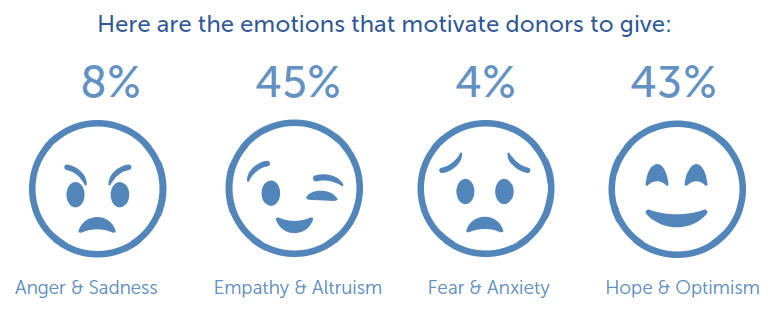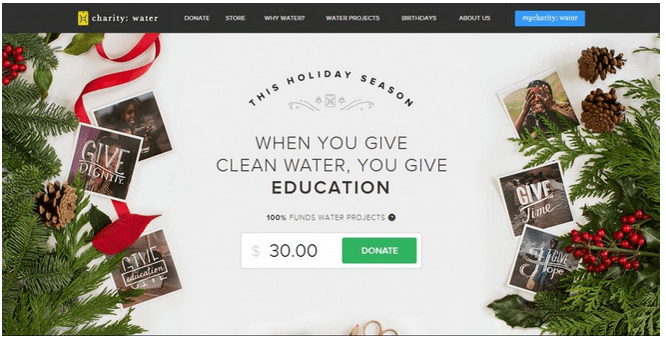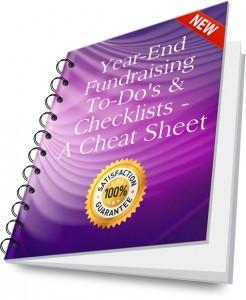
Arrgh! Too crowded! Too competitive! Too much noise! I’m curling into a fetal position until it’s over!
Do you have that year-end feeling? You know, the one many fundraisers get around this time of year?
Kind of frenetic? Anxious? Stressed?
You’re not alone.
The average nonprofit receives 26 – 30% of all donations in December. And 10% arrive in the last three days of the year! So, yeah, it’s really busy. And a lot is on the line.
I was talking with one of my clients, who apologized for acting so frantic and rushed. She said:
“Do you remember having that feeling? Did you get it when you used to work in the trenches? That worry that maybe you won’t hit your numbers? That people won’t give as much as they gave last year? That some of your major donors won’t renew. That maybe you’re not sending enough emails? That you’ll wake up on January 1st and be in BIG trouble?”
Oh, yeah. That feeling…
Of course I’ve felt it! But over the years I’ve learned a few tricks to help overcome that feeling.
14 Year-End Fundraising Tips to Boost Results
1. Ask all your board members to give passionately!
If the board won’t lead, why should anyone else follow? I’m sure I’m not the only development practitioner who’s been asked “What does your board give?” by a prospective foundation or individual donor. You absolutely must be able to answer: “They all give passionately!”
In considering whether and how to get involved with any nonprofit, people will look first to the board for guidance. You ignore this at your peril. See How to Handle Nonprofit Boards Who Won’t Play Nice.
2. Ask all your staff to give!
Nothing impresses donors more than being told all the staff make donations because they care so much about the mission. I”ve had the privilege of working at more than one organization like this, and it has been my pleasure to give and encourage my colleagues to give as well. There is one caveat: Don’t abuse power dynamics. Staff giving shouldn’t be mandatory, and it absolutely can be anonymous. If you have a culture of abundance, generosity and philanthropy, your staff will likely feel good about giving. So give them the opportunity to get a shot of “feel good” dopamine by including them in your annual campaign! If your culture is oppressive, and people constantly complain of being overworked and underpaid, then you have a different problem. Forego the staff ask and get to work on a plan to move towards a more humane work culture that sparks joy in everyone who engages with you.
TIP: A local Starbucks used to donate coffee and pastries for a week while we ran our “Staff Friends Campaign.” We included signage in the staff break room: “Starbucks salutes you and all the Friends of [our organization name] who make a difference in the lives of so many in our community!” We then followed with instructions: “Help yourself to coffee and pastries as a thank you for all you do! If you are able, please consider joining the annual Friends Campaign that funds our essential work all year long. Every gift means a lot. SImply drop your gift directly into the jar, or complete the envelopes provided so we can thank you personally. You are the best!” .
3. Call your lapsed donors!
Often people simply forget they’ve not renewed. They need you to nudge them a little by reminding them they’ve already made the decision to support your cause. (This is one of Robert Cialdini’s 6 Principles of Influence, known as “commitment and consistency.” Once we’ve made commitments, we’re naturally inclined to want to keep them). You’ve already got a foot in the door with these donors; you just need to walk inside!
If you don’t have time to call everyone, pick those who are most important (e.g., larger donors, first-time $100+ donors, active volunteers, etc.). Consider holding a mini-phonathon and asking volunteers to help make these important calls. When you don’t reach someone in person, leave a brief, friendly message with your contact info so they can call, text or email you back. Let them know you’ll follow up by email, and they’ll also be receiving a “we miss you” mailing. Assure them they can also give via phone or directly from your website. Immediately send a follow-up “sorry we missed you” note with a remit envelope to anyone you weren’t able to reach.
4. Get your year-end mailing out ASAP if it’s not out already.
Never think “I missed the deadline; guess it’s too late.” Just do it!
Check it over to make sure you’re covering all the essentials. Be specific, both regarding purpose and amount. Use one good story to illustrate your success. Stay away from lots of data. Avoid ego-centricity; your appeal shouldn’t be filled with “we,” “our,” “us,” “name of your organization.” Use a P.S. to stress your most compelling arguments – e.g., what the gift will accomplish, and why they should give right now (90% read the P.S. after the salutation and signature, so make it count).
5. Add a photo of someone helped.
Do this every place you can think of. Print. Email. Social media. Website. Donation Landing Page. Thank You Landing Page. Even your email signature. Visuals truly are worth 1000 words – which is extremely useful when you’re competing for limited attention spans! Should you use a happy or sad image? The jury is out. I’ve often used sad ones for appeals and happy ones for thank you’s. But were I to have to choose this year, I might try happy. Why? Because during times of stress, people yearn to be aligned with some positivity

In fact, 91% of holiday donors say hope and optimism are what motivate them to give. Donors want to be inspired, not scared into supporting your cause. Be sure you show and tell stories that demonstrate the positive impact of your donors’ dollars. Hopeful donors are happy donors.
6. Add a lightbox.
The form-based box that pops up over a website with a call-to-action is called a lightbox, splash page, shadow box, pop-up, or highjacking. It usually pops up the first time folks come to you for the period for which you set it up – perhaps once/day during the four to six weeks you’re running your year-end campaign. [The best advice I’ve heard is if your visitor dismisses the popup, don’t show it to them again for at least a week].
You or your leaders might find them annoying. But they work. And they work especially well for targeted campaigns like the end of the calendar year. Your conversion rate from prospect to donor goes up with a light box because more people will see your call-to-action. They can’t help but notice it, because you’ve put it right in their faces. I first used one when working at a food bank, and it increased online donations during that period by almost 30%. It may/may not work for you, but it’s worth testing.
Here’s one that pops up on the home page of Vida Joven.
Note: You’ll probably want to disable popups on mobile devices. Not all mobile devices can handle popups… and not all popups can handle mobile devices.
7. Make your home page your donation page.
This is an alternative to a lightbox. Some organizations revamp their home page during the holidays so their fundraising message is front and center.
In past years, Charity: water has consistently provided an excellent example.

8. Make sure you’ve set up a dynamic thank you page and autoresponder thank you email for donors who give online.
When donors give online, they should immediately be taken to an inspiring thank you landing page that makes them feel great about having given. Your email server should then automatically send an email thank you. Make sure you’ve looked at these and are persuaded they’re doing their job. Don’t make this simply a transactional receipt that’s all about the money. A transformational thank you should make the donor feel good about the impact they helped make possible.
9. Double check who your e-appeal is coming from, and make sure it’s the right person.
Some folks think the ‘from’ line is more important than the subject line. Because people open email from folks they know. Write from a person; not an organization. Ideally this will be someone your targeted reader knows and likes. Often this will be the E.D. It could also be another beloved staff member (Perhaps… the volunteer coordinator? A teacher? A doctor on staff? A founder?).
Even when you have a trusted brand, you’ll likely get a better response when sending your email from the person at the brand. Especially if folks have come to know this person, and know them to be funny, warm, interesting, provocative or whatever personal, authentic traits with which they’re associated. Remember: Every message you send is a relationship-building opportunity. It’s your job, as a philanthropy facilitator, to grab that opportunity with both hands!
10. Write a great e-appeal subject line and preview pane header.
Your email subject line is to your e-appeal like your carrier envelope is to your mailed appeal. It must SCREAM “Open Me!” The preview pane gives you a little assist (it’s the beginning of the first sentence that many folks will see if they have “preview pane” enabled on their Outlook or Google mailbox. Also keep in mind that you have only a few seconds to capture attention. Subject lines with fewer words and less characters have noticeably higher open and click-through rates. See here for more on great email subject lines.
NOTE: Keep in mind that many folks will open your email on a mobile device, so make sure your email is mobile friendly. Test it on more than one device and browser (e.g., Android and iPhone; Firefox, Safari, Google and Chrome) to be safe.
11. Make sure your e-appeal is personal, genuine and even fun.
Avoid sounding formal and stilted. You’re having a conversation with your potential donor. Talk like you would in a real conversation!
TIP: Read it aloud and, if it sounds awkward, rephrase. Contractions are okay. Even to begin a sentence. And cross out the egocentric pronouns like “I,” “we,” and “our.” No one likes someone who talks about themselves all the time.
12. Get social!
Send out some posts on whatever social platform your constituents use most frequently to remind folks of your mission and accomplishments. Besides the fact you’ll reach folks you’d otherwise not reach, you’ll also predispose your current supporters to give to you when asked.
Make your posts as grateful, generous and ‘feel good’ as possible. Do this daily if you can. Your goal is to ‘pre-suade’ donors to give by offering up little gifts of meaningful content.
13. Write your thank you letters now.
Spend as much time on thank you copy as fundraising copy. Make sure your donor feels like a mensch. Don’t wait to get started on crafting this copy, because if you do you’ll likely not get your thank you letter out to your donor in a timely manner. Think of it this way:
If you ask well, you may get a gift. If you thank well, you may get a lifetime of gifts.
14. Have an inspiring out-of-office message.
If there’s any time your desk won’t be covered during the crucial weeks leading up to December 31st, make sure you let folks know how to make a gift! Do this both (1) for your personal email and (2) for your voicemail. And make sure the main number has a great year-end message as well.
Elements to include: Great greeting and/or subject line. Contact info should they really need to reach you. Personal, warm tone. Call to action for end-of-year campaign.
Make your year-end list and check it twice!
Then… stay positive. Keep smiling. Don’t worry. You’ve got this! And I have your back.
Want More Help with Year-End Fundraising?

63 pages filled with year-end fundraising tips in this comprehensive Solution Kit
If you’ve got your year-end fundraising plan completely under control, yay you! If you need to spend a bit of time making a list of ‘to-do’s, now’s a good time. Grab my Year-End Fundraising Solution Kit – To-Do’s and Checklists. It’s a 63-page-long, step-by-step comprehensive road map to effective year-end fundraising. After working 30+ years in the trenches, I can vouch for this stuff. It’s tried and true! Not satisfied? All Clairification products come with a 30-day, no-questions-asked, money-back guarantee. You truly can’t lose!
And if you can’t do everything you wish you could this year, get ahead of the game and put it on your list for next year.
Photo by Claire Axelrad as part of a series: The Art of Philanthropy – ‘Love of Humankind’ – as Seen Through the Prism of the World’s Art Museums






